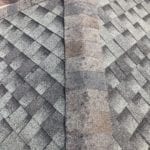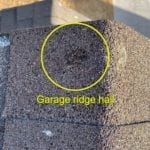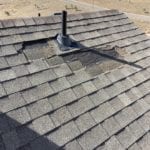How to Inspect Your Roof for Hail Damage

How can you tell if you have hail damage to your roof? Here are a three easy DIY hail damage checks that you can do from the ground before you call a roofing company or your insurance company. Warning: Don’t climb up on your roof unless you are trained to do so. Inspecting a roof for damage can be dangerous. These DIY Roof Hail Damage tips can be done from the ground level.
-
Granules Piled Up in Your Gutter Downspout
The roof pictured here was a complete loss because it lost a large percentage of its granule top layer. You have a good indicator of damage if you have a pile of granules flushed out of your gutter downspouts after a hail event. This roof took enough hits that the granule protective layer was dislodged, exposing the underlayer – which is not designed to protect your building alone – it needs the protective granule layer above it.
If enough hail strikes remove this protective granule covering, insurance will need to replace your roof. There are other issues as well that an adjuster will look for, including penetrations, which can happen with large hailstones.
-
Dents and Impact Marks in the Roof Visible from the Ground
Hailstones often leave a mark. This is especially visible just after a storm. After several days of hot sun on a roof, many of these dents will lessen so it’s important to check early after the storm. On occassion, homeowners are on vacation when a huge hail storm hits and they don’t even know their roof was damaged until months or years later.

A roof is considered a “complete loss” by an insurance adjuster if it meets several criteria based on the roof type. A roof needs to protect the inside of the building from water and other external influences. Every roofing system has various elements that work together to protect the building. The insurance adjuster analyzes each building to determine if the roof is secure or if it needs repair or if it requires complete replacement.
-
Shingle Parts and Pieces in Your Yard
Hail storms often include strong wind. As a roof is getting battered by hail, often wind is also lifting shingles from their pads, ripping off pieces and sending them down into the yard. If you find shingle parts in your yard, there is a good chance you need to have someone look at it. A missing shingle is an open hole into the underlayment or decking below it.

These are three easy tips for you to look for after the next storm. You can do all of them safely just by walking around your property. If you find any of these telltale signs it’s worth a call to your local roofing company. Most all roofing contrators will offer a free estimate so there is no cost to you.
If you decide you need your roof inspected, give us a call at New Roof Plus to set a time to analyze the condition of your roof. We are certified roof inspectors, so you will get a licensed professional with the highest credentials for roof inspection.


